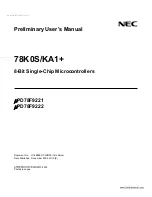
5
Understanding Outputs
Taralist Controllers are capable of controlling up to 256 Relays from only one
Taralist CPU. These controllers are available with 1, 2, 4, 8, 16, 24, and 32 relays
on a printed circuit board as well as a small controller with only an XR expansion
port instead of relays. XR Expansion Relays may be added to the XR Expansion
Port at any time giving you as many relays as you need (up to 256).
A relay is similar to a switch. The only difference between a switch and a relay is
the actual mechanism for changing the on/off status of the switch. On a switch,
you manually push on a piece of metal or plastic to operate the switch. On a relay,
an electric current is used to operate the switch. We will use the work “relay to
indicate a switch that is controlled by the Taralist controller.
Relays do NOT provide a voltage output. They provide a contact closure output,
exactly like the terminals found on a light switch at your local hardware store.
Wiring to a relay will be slightly different depending on the model of Taralist
controller you choose.
Some relays, such as the 5A and 10A versions, have a screw terminals that can
accept 12 Gauge or smaller wire. Other versions, such as the 20A and 30A relays,
have a .250” Quick Connect terminal (the appropriate mating connector can be
found at any hardware or automotive supply store). Our 20A HP series relays will
accept wires as large as 10 Gauge.
Again, relays do not provide a voltage output. They ONLY switch whatever
voltage you supply into the relay.
Relays are available in SPST, SPDT, and DPDT configurations. In addition, both
Mechanical and Solid State relays will be supported by the Taralist series. If you
are unfamiliar with the different versions of relays available, you can review
, which explains these relay types in great detail. The article will help you
determine the best type of relay for your application, showing you the formulas
for calculating relay sizes that are appropriate for your application.
If you intend to use the Taralist series relay controllers for inductive applications,
. An example of an inductive application is any device
that involves motion. For instance, using a Taralist Controller to control a motor,
a solenoid, or a valve. Other types of inductive applications include anything with
a transformer such as a fluorescent light or a power transformer of any kind.
Logic circuits (including those found on the Taralist Controller) may malfunction
in sever conditions. The above article will show you how to safely implement
these kinds of loads which greatly reduces the chances of a malfunction. Some
inductive applications generate excessive noise, and may not be suitable for use
with the Taralist Series Relay controllers. Solid State Taralist Relay Controllers
should be considered for these high-noise applications.











































